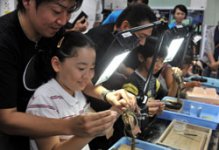Cyril Roger Brossard
Well-known member
- Joined
- Aug 30, 2012
- Messages
- 408
This is a bit old, but I found the idea quite good.
MISAKI, Kanagawa Pref. ? It was a long way from the high-class jewelry showrooms of Paris, London or Tokyo's Ginza, but on Thursday at Misaki, on the windswept tip of Kanagawa Prefecture's Miura Peninsula, 20 elementary school children were treated to a rare, hands-on look at pearls and how they form.

Pearl dreams: Asaki Katayama, 10, from Kokubunji in Tokyo, inserts the "nucleus," around which a pearl is expected to form, into a pearl oyster during an event hosted by the Misaki Marine Biological Station in Misaki, Kanagawa Prefecture, on Thursday. YOSHIAKI MIURA PHOTO
The event was hosted by the Misaki Marine Biological Station, a 124-year old research facility affiliated with the University of Tokyo, in collaboration with leading pearl producer Mikimoto.
In April 2009, the firm opened a satellite office of its Pearl Research Laboratory within the Misaki facility.
Professor Koji Akasaka, who heads the biological station, explained that his facility, which hosts up to 20,000 researchers and students annually, regularly holds events for the public.
"It is one of our tasks to inform people about marine life," he said.
Mikimoto spokeswoman Yukiko Toshishige added, "As a company, we want to do more to increase awareness of all aspects of pearls, including how they are made."
The event Thursday was the first time in Mikimoto's 120-year history that it has provided an opportunity for children to experience the crucial "nucleus insertion" step in the pearl production process.
The children carefully negotiated the complex technique, in which the shell of an Akoya pearl oyster (Pinctada fucata) is pried open and the "nucleus" ? a small rounded fragment of shell ? is inserted inside its flesh. If all goes well, the oyster will coat the nucleus in secretions, forming a pearl in about 18 months' time.
"I thought it would have been easier," said Taichi Kashimura, 11, from Yokohama. "The nucleus was too big to fit at first, but I eventually got it in."
Kashimura's mother explained that she found out about the event in a newspaper. "We have all seen pearls before, but we don't know much about how they are actually made," she said.
Tatsuya Sato, 11, said he wanted to participate in the event because, "I like the ocean and sea life." The young Kamakura resident said he hopes to become a marine biologist.
Article by EDAN CORKILL
Aug 2010.
MISAKI, Kanagawa Pref. ? It was a long way from the high-class jewelry showrooms of Paris, London or Tokyo's Ginza, but on Thursday at Misaki, on the windswept tip of Kanagawa Prefecture's Miura Peninsula, 20 elementary school children were treated to a rare, hands-on look at pearls and how they form.

Pearl dreams: Asaki Katayama, 10, from Kokubunji in Tokyo, inserts the "nucleus," around which a pearl is expected to form, into a pearl oyster during an event hosted by the Misaki Marine Biological Station in Misaki, Kanagawa Prefecture, on Thursday. YOSHIAKI MIURA PHOTO
The event was hosted by the Misaki Marine Biological Station, a 124-year old research facility affiliated with the University of Tokyo, in collaboration with leading pearl producer Mikimoto.
In April 2009, the firm opened a satellite office of its Pearl Research Laboratory within the Misaki facility.
Professor Koji Akasaka, who heads the biological station, explained that his facility, which hosts up to 20,000 researchers and students annually, regularly holds events for the public.
"It is one of our tasks to inform people about marine life," he said.
Mikimoto spokeswoman Yukiko Toshishige added, "As a company, we want to do more to increase awareness of all aspects of pearls, including how they are made."
The event Thursday was the first time in Mikimoto's 120-year history that it has provided an opportunity for children to experience the crucial "nucleus insertion" step in the pearl production process.
The children carefully negotiated the complex technique, in which the shell of an Akoya pearl oyster (Pinctada fucata) is pried open and the "nucleus" ? a small rounded fragment of shell ? is inserted inside its flesh. If all goes well, the oyster will coat the nucleus in secretions, forming a pearl in about 18 months' time.
"I thought it would have been easier," said Taichi Kashimura, 11, from Yokohama. "The nucleus was too big to fit at first, but I eventually got it in."
Kashimura's mother explained that she found out about the event in a newspaper. "We have all seen pearls before, but we don't know much about how they are actually made," she said.
Tatsuya Sato, 11, said he wanted to participate in the event because, "I like the ocean and sea life." The young Kamakura resident said he hopes to become a marine biologist.
Article by EDAN CORKILL
Aug 2010.
